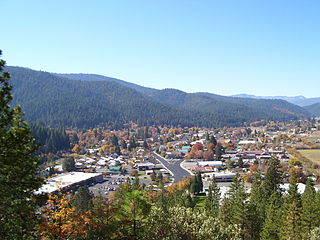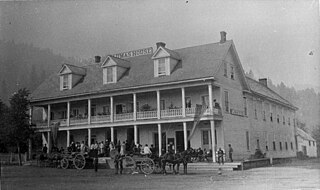
Plumas County is a county in the Sierra Nevada of the U.S. state of California. As of the 2020 census, the population was 19,790. The county seat is Quincy, and the only incorporated city is Portola. The largest community in the county is East Quincy. The county was named for the Spanish Río de las Plumas, which flows through it. The county itself is also the namesake of a native moth species, Hadena plumasata.

Quincy is a census-designated place and the county seat of Plumas County, California. The population was 1,630 during the 2020 Census, down from 1,728 during the 2010 Census, and 1,879 during the 2000 Census.

The Gold Country is a historic region in the northern portion of the U.S. state of California, that is primarily on the western slope of the Sierra Nevada. It is famed for the mineral deposits and gold mines that attracted waves of immigrants, known as the 49ers, during the 1849 California Gold Rush.

Henry Peter Haun was a California judge, farmer, and U.S. Senator from California. He was appointed by Governor John B. Weller to serve out the remaining four months of Senator David C. Broderick's term following his predecessor's death in a duel in 1859.

Elizabethtown, California was a California Gold Rush town that began in 1852 in Plumas County, California. It was named after a woman in the miners camp called Elizabeth Stark Blakesley.

Empire Mine State Historic Park is a state-protected mine and park in the Sierra Nevada mountains in Grass Valley, California, U.S. The Empire Mine is on the National Register of Historic Places, a federal Historic District, and a California Historical Landmark. Since 1975 California State Parks has administered and maintained the mine as a historic site. The Empire Mine is "one of the oldest, largest, deepest, longest and richest gold mines in California". Between 1850 and its closure in 1956, the Empire Mine produced 5.8 million ounces of gold, extracted from 367 miles (591 km) of underground passages.
Charles Augustus Wheaton (1809–1882) was a businessman and major figure in the central New York state abolitionist movement and Underground Railroad, as well as other progressive causes. He was one of the founders of the First Congregational Church in Syracuse, which took an abolitionist stand, and was part of the Vigilance Committee that formed in 1850 to resist the Fugitive Slave Law.

Colonel Isaac Neff Ebey was the first permanent white resident of Whidbey Island, Washington.
William Greeneberry "Green" Russell (1818–1877) was an American prospector and miner.

Plumas-Eureka State Park is a California state park located in the Sierra Nevada and Cascade Range in Plumas County, California.

The Keddie murders are an unsolved quadruple homicide that occurred over the night of April 11–12, 1981 in Keddie, California, United States. The victims were Glenna Susan "Sue" Sharp, daughter Tina Louise Sharp, son John Steven Sharp and John's friend Dana Hall Wingate.

Carl Christian Heinrich Nahl, later known as Charles Nahl, was a German-born painter who lived in the United States for the last half of his life. He lived most of those 30 years in California and is considered among the state's first significant painters.

The Lyons Station Stagecoach Stop,, was a tavern and stagecoach stop near the southwest corner of Newhall Avenue and Sierra Highway, by Eternal Valley Cemetery. The site is located in the present day Newhall section of Santa Clarita, in Los Angeles County, California.
Buckeye is a former travel station about halfway along the Oroville–Quincy Highway in Plumas County, California, near the border with Butte County. It lay at an elevation of 4,997 feet (1,523 m). The station stood as late as 1866, when it was noted in the Plumas County boundary survey.

The California Digital Newspaper Collection (CDNC) is a freely-available, archive of digitized California newspapers; it is accessible through the project's website. The collection contains over six million pages from over forty-two million articles. The project is part of the Center for Bibliographical Studies and Research (CBSR) at the University of California Riverside.

The American Ranch on the Beckwourth Trail, was a 160-acre farm and lodging house located in the American Valley, now Quincy, California.
The Plumas County Museum is a 501(c)3 organization and historical museum located in Quincy, California. Exhibits focus on Plumas County, including the Maidu people, the California Gold Rush, the logging industry, and the local community.
John Cobb was an American pioneer. He was born in Kentucky, then moved frequently from farm to farm in Midwestern United States before taking his family across the Great Plains and the Rocky Mountains to California in 1850–1851. Here he continued to move frequently before finally settling in what is known as Cobb Valley in Lake County, California, the first European to settle in the region. His name survives in Cobb Mountain and the village of Cobb, California, both in Lake County, California.

Charles Fayette Lott was a California judge who served one term in the California State Senate.

Plumas House was a historical building in Quincy, California. The site of the Plumas House building is a California Historical Landmark No. 480. The first building at the site was built in 1853. The second building that replaced the original was built by James and Jane Edwards in 1866. The Edwards building was a Hotel with a Ballroom, restaurant, and parlor. The Hotel caught fire on June 23, 1923, with no hope to save it. The fire did not spread to other buildings with the help of the volunteer fire department. The two buildings served the town and the 49er California Gold Rush miners. The town of Quincy was named by James Bradley after his hometown of Quincy, Illinois. The Plumas House was busy, as Quincy was the county seat for Plumas County. A historical marker is in the town center park at the Southwest corner of Main Street and Court Street.














